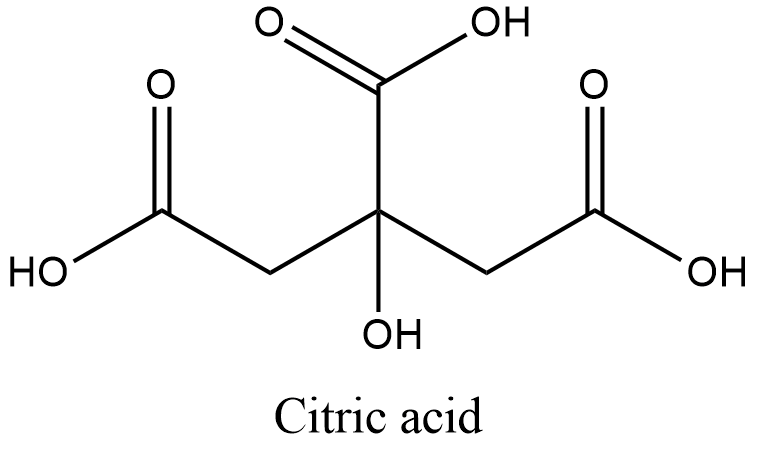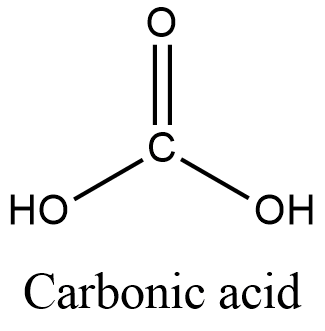
Which one of the following is not an organic acid?
(A) Ethanoic acid
(B) Formic acid
(C) Citric acid
(D) Carbonic acid
Answer
489.6k+ views
Hint: The question is asking to choose an inorganic acid. Recollect the basic fundamentals of organic chemistry. Find out where are the acids given in the options are used in our daily life. Find out which of the acids have carboxyl groups in them and accordingly, mark them as organic or inorganic and then tick the correct option.
Complete step by step solution:
- A compound is said to be organic if it has at least one hydrocarbon chain in it.
- Organic chemistry is basically the chemistry of organs, that is, living beings. All living beings are composed of hydrocarbons as the backbone.
- In organic chemistry, an organic acid will have the functional group as carboxylic acid
- Let’s now have a look at the acids given in the question.
- Ethanoic acid is also commonly known as acetic acid. In dilute form, it is used as vinegar for cooking. The structure of acetic acid is
- Formic acid is methanoic acid. You must have felt an itching sensation when an ant bites you. This is because ant sting contains formic acid which causes irritation. The structure of formic acid is
- Citric acid reminds us of citrus fruits. All citrus fruits contain citric acid. Its structure is,

Therefore, citric acid is also an organic acid due to the presence of three carboxylic groups.
- Carbonic acid has the molecular formula,

- Although carbonic acid is present in our stomach and part of the digestive process, it doesn’t contain C-H bond and therefore, it is not an organic acid. It is an inorganic acid.
- Therefore, the answer is option (D).
Note: Remember for a compound to be organic in nature, it should have at least one carbon-hydrogen bond. Organic acids will have the presence of a carboxylic acid group. Inorganic acids are the mineral acids or acids which do not contain the presence of carbon-hydrogen bonds.
Complete step by step solution:
- A compound is said to be organic if it has at least one hydrocarbon chain in it.
- Organic chemistry is basically the chemistry of organs, that is, living beings. All living beings are composed of hydrocarbons as the backbone.
- In organic chemistry, an organic acid will have the functional group as carboxylic acid
- Let’s now have a look at the acids given in the question.
- Ethanoic acid is also commonly known as acetic acid. In dilute form, it is used as vinegar for cooking. The structure of acetic acid is
- Formic acid is methanoic acid. You must have felt an itching sensation when an ant bites you. This is because ant sting contains formic acid which causes irritation. The structure of formic acid is
- Citric acid reminds us of citrus fruits. All citrus fruits contain citric acid. Its structure is,

Therefore, citric acid is also an organic acid due to the presence of three carboxylic groups.
- Carbonic acid has the molecular formula,

- Although carbonic acid is present in our stomach and part of the digestive process, it doesn’t contain C-H bond and therefore, it is not an organic acid. It is an inorganic acid.
- Therefore, the answer is option (D).
Note: Remember for a compound to be organic in nature, it should have at least one carbon-hydrogen bond. Organic acids will have the presence of a carboxylic acid group. Inorganic acids are the mineral acids or acids which do not contain the presence of carbon-hydrogen bonds.
Latest Vedantu courses for you
Grade 8 | CBSE | SCHOOL | English
Vedantu 8 CBSE Pro Course - (2025-26)
School Full course for CBSE students
₹42,500 per year
Recently Updated Pages
Express the following as a fraction and simplify a class 7 maths CBSE

The length and width of a rectangle are in ratio of class 7 maths CBSE

The ratio of the income to the expenditure of a family class 7 maths CBSE

How do you write 025 million in scientific notatio class 7 maths CBSE

How do you convert 295 meters per second to kilometers class 7 maths CBSE

Write the following in Roman numerals 25819 class 7 maths CBSE

Trending doubts
Give 10 examples of unisexual and bisexual flowers

Draw a labelled sketch of the human eye class 12 physics CBSE

Differentiate between homogeneous and heterogeneous class 12 chemistry CBSE

Differentiate between insitu conservation and exsitu class 12 biology CBSE

What are the major means of transport Explain each class 12 social science CBSE

Franz thinks Will they make them sing in German even class 12 english CBSE




